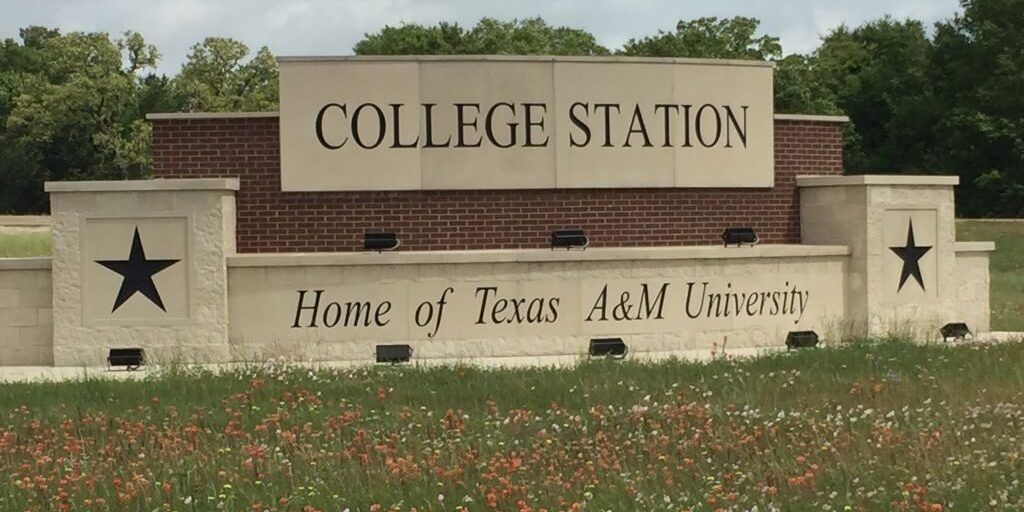
COMMUNITIES WE SERVE
Bryan, College Station, Navasota and Surrounding Areas.
We are pleased to serve these wonderful communities and we promise to do our best to continue the great traditions of quality work for our customers, who are also our friends and neighbors in the cities of Bryan, College Station, Navasota and the surrounding areas. College Station has a unique history, we hope you enjoy reading this.
A Brief History of College Station, Texas:
College Station, Texas is a young city, with its beginnings very much tied to the founding and growth of The Agricultural & Mechanical College of Texas, now known as Texas A&M University. However, to tell the full story we need to go back to when this area was contested by France and Spain. Although the renowned French explorer LaSalle had earlier claimed lands for France on both sides of the Mississippi River, subsequent dealings (to very much simplify things) made this area a colony of the Spanish Crown, part of their New World territories known as New Spain.
Stephen F. Austin’s Second Colony included pioneers and homesteaders who settled the area during the 1820’s and 1830’s around what would become the site of The Agricultural & Mechanical College of Texas. In 1859, The Houston and Texas Central Railroad Company (H&TC RR) began to grade a railroad bed through the area. Railroad construction was halted during the Civil War. Railroad construction resumed in 1866, so in 1867 the railroad line ran through the area, along with telegraph service that paralleled the railroad line. The first courthouse for Brazos County was built in nearby Bryan, Texas in 1871. All during the pioneer era, new homesteaders of German, Czech, and Italian descent became established through the area.
The State of Texas in 1871 formally established The Agricultural & Mechanical College of Texas under the federal Morrill Act of 1862. Citizens of Brazos County offered 2,416 acres of land to a commission that was charged with finding a location for the new institution. Additionally, the H&TC RR line across South-east Texas to Bryan ran through the land offered, which helped make the decision. The commission’s acceptance of that offer gave a place to begin building classrooms, agricultural facilities, dormitories, armories, parade grounds and other military training grounds for the Corp of Cadets, which in the beginning included all students.
(continued below photo)

Which brings us to the beginning of “College Station.”
When the college opened in 1876 to forty students it was isolated. There was not yet a railroad depot. There was not a town. The fledgling college was a short distance away. The H&TC RR conductors would announce this railroad passenger stop as “College Station” which is the origin of the town’s name.
In 1877 the U.S. Postal Service designated the area “College Station” and opened a post office in a building near the railroad tracks. A H&TC RR depot was constructed in 1883, and a second depot in 1900 just east of the first, by the International & Great Northern Railway on its newly built line. Passenger service continued at this location until 1959. A historical marker is on the site, which is now on Old Main Drive just east of its intersection with Welborn Road.
By 1884 the community had 350 residents and two general stores. Most faculty members lived on campus in college-provided housing. Electrical service was established in the 1890s. The 1900 census counted 391 population. By 1910 an electric interurban railroad connected College Station to nearby Bryan. Partly due to the interurban a business district developed just north of the campus over the next decade. The community developed in all directions during the 1920s and 1930s as the college grew.
The City of College Station incorporated in 1938, making it one of the youngest cities in Texas. A zoning commission was established that year and the city has maintained a tradition of managed growth ever since. Also in 1938 the remaining faculty living on campus were told to move. So the housing need grew in College Station. The 1940 census found 2,184 inhabitants (not including students) and sixty businesses. In 1942 Ernest Langford was first elected as mayor. He would hold that office for twenty-six years. He emphasized developing city services over commercial expansion, and is often called the “Father of College Station.” There were 7,898 inhabitants in 1950, including students. In 1959, under the leadership of college president General James Earl Rudder, a major expansion of newly re-named Texas A&M University began. The City of College Station has grown with the school, which is now a highly regarded, tier-one research university with an enrollment of about 65,000. College Station population grew from 11,396 in 1960, to 17,676 in 1970, to 30,449 in 1980, 52,456 in 1990, and 67,890 in 2000. Almost a sixfold increase in only four decades.
Even with such rapid growth, College Station residents enjoy a great quality of life. Businesses of all kinds benefit from the economic multipliers of the high-tech manufacturing industries and the major research facilities located in and around College Station, and that have ties to the university. This helps make the employment and business start-up environment very healthy. With 75% of the Texas and Louisiana population within a three and one-half hour drive, a large market is nearby.
And when one is not at work, there are plenty of residential and recreational options. Many nice housing additions of all kinds are located in all parts of the city. Families and children of all ages can enjoy a day at any of the 56 parks. These include everything from tradition picnicking and playgrounds to outdoor music evenings to organized programming with swimming and a complete roster of youth sports leagues all year round. And the vacation options of all of Texas are within a day’s drive. For dining and cinema well over one hundred options await. An outstanding public school and libraries system provides top quality education. Private schools and active home schooling networks give additional school choices. Many highly rated hospitals and clinics provided highly regarded health care. While College Station maintains a small-city feel with plenty of rural countryside nearby, the major urban area of Houston, Austin, Dallas, and San Antonio are easily accessed.
So from its modest beginnings as an 1876 whistle-stop where college freshmen stepped off a coal burning steam-engine train to an open field to walk about a quarter-mile across a treeless prairie to an isolated, one-building campus of six faculty and forty students, College Station has continued to grow and be a great place to live.